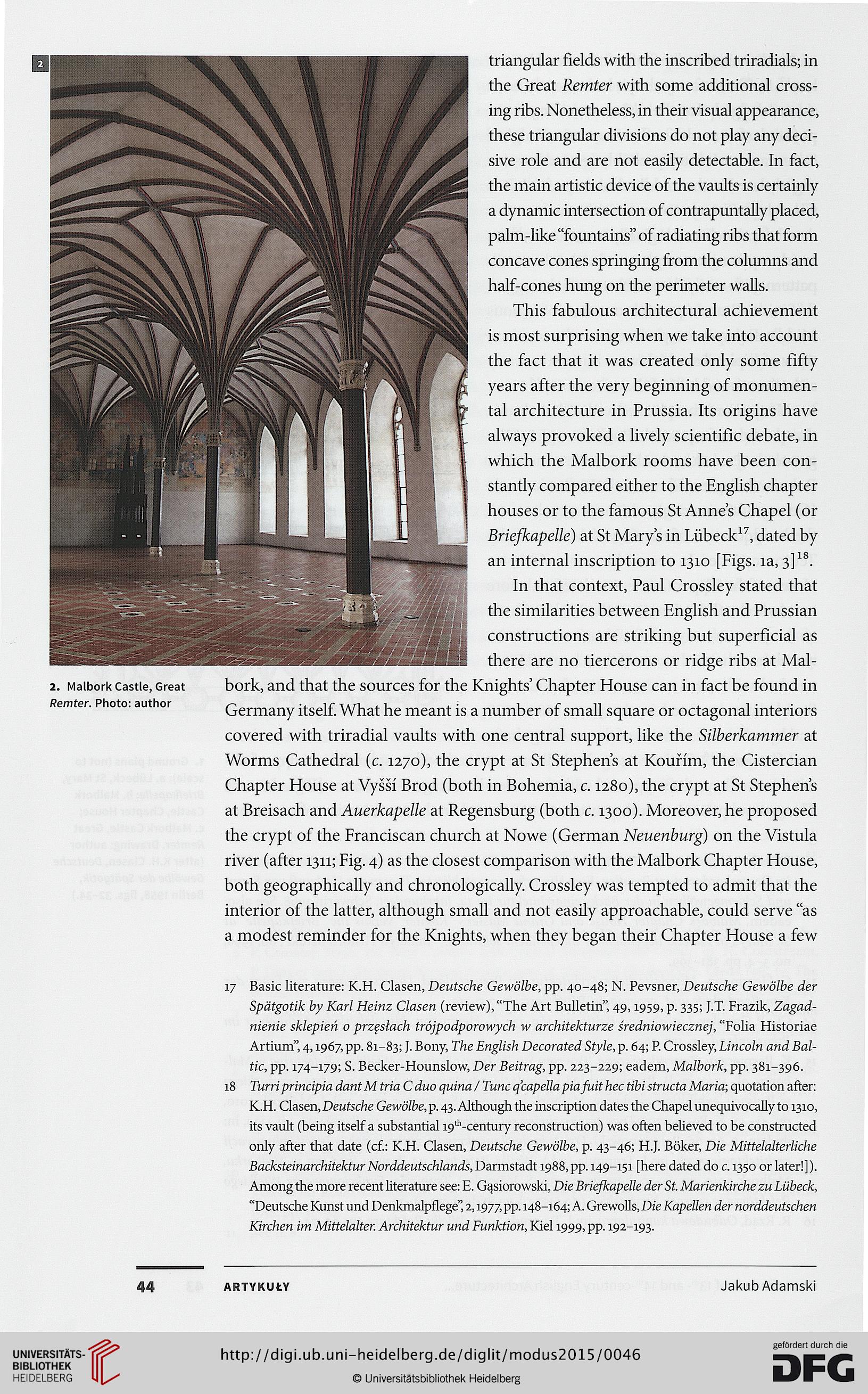2. MatborkCastte.Great
Remfer.Photo: author
triangular fields with the inscribed triradials; in
the Great Rctnfer with some additional cross-
ing ribs. Nonetheless, in their visual appearance,
these triangular divisions do not play any deci-
sive role and are not easily detectable. In fact,
the main artistic device of the vaults is certainly
a dynamic intersection of contrapuntally placed,
palm-like "fountains" of radiating ribs that form
concave cones springing from the columns and
half-cones hung on the perimeter walls.
This fabulous architectural achievement
is most surprising when we take into account
the fact that it was created only some fifty
years after the very beginning of monumen-
tal architecture in Prussia. Its origins have
always provoked a lively scientific debate, in
which the Malbork rooms have been con-
stantly compared either to the English chapter
houses or to the famous St Anne's Chapel (or
Bn'c/kapHle) at St Marys in Lubeck^, dated by
an internal inscription to 1310 [Figs. 1a, 3]^.
In that context, Paul Crossley stated that
the similarities between English and Prussian
constructions are striking but superficial as
there are no tiercerons or ridge ribs at Mal-
bork, and that the sources for the Knights' Chapter House can in fact be found in
Germany itself. What he meant is a number of small square or octagonal interiors
covered with triradial vaults with one central support, like the at
Worms Cathedral (c. 1270), the crypt at St Stephens at Kouflm, the Cistercian
Chapter House at Vyssf Brod (both in Bohemia, c. 1280), the crypt at St Stephens
at Breisach and AMerA;<3pe& at Regensburg (both c. 1300). Moreover, he proposed
the crypt of the Franciscan church at Nowe (German NcMen&Mrg) on the Vistula
river (after 1311; Fig. 4) as the closest comparison with the Malbork Chapter House,
both geographically and chronologically. Crossley was tempted to admit that the
interior of the latter, although small and not easily approachable, could serve "as
a modest reminder for the Knights, when they began their Chapter House a few
17 Basic literature: K.H. Clasen, Deutsche Gewdlke, pp. 40-48; N. Pevsner, Deatsclie Gewdihe der
Spafgotik by Karl Heinz Clasen (review), "The Art Bulletin", 49,1959, p. 335; J.T. Frazik, Zagad-
nienie sklepień o przpdnrfi i ró;p o dp o ro wy cń w architekturze średniowieczne;, "Folia Historiae
Artium", 4,1967, pp. 81-83; J. Bony, The English Decorated Style, p. 64; P. Crossley, Lincoln and Bal-
tic, pp. 174-179; S. Becker-Hounslow, Der Beitrag, pp. 223-229; eadem, Malbork, pp. 381-396.
18 Tarriprincipia dant M tria C dno ryaina / Lanc capelia pia/ait hec tiki stracta Maria; quotation after:
K.H. Clasen, Deatsclie Gewdlhe, p. 43. Although the inscription dates the Chapel unequivocally to 1310,
its vault (being itself a substantial 19'Wentury reconstruction) was often believed to be constructed
only after that date (cf.: K.H. Clasen, Deatscńe Gewdlhe, p. 43-46; HJ. Boker, Die Mittelalterliclie
Bac/rsfeinarc/iitekfar APrddeafscliiands, Darmstadt 1988, pp. 149-151 [here dated do c. 1350 or later!]).
Among the more recent literature see: E. Gąsiorowski, Die Brie/kapelle der St. Marienkirche za Liibeck,
"Deutsche Kunst und Denkmalpflege" 2,1977, pp. 148-164; A. Grewolls, Die Knpeiien der norddeutschen
Kirclien im Mittelalten Arciiitekiar and Bankdon, Kiel 1999, pp. 192-193.
44
ARTYKUŁY
Jakub Adamski




